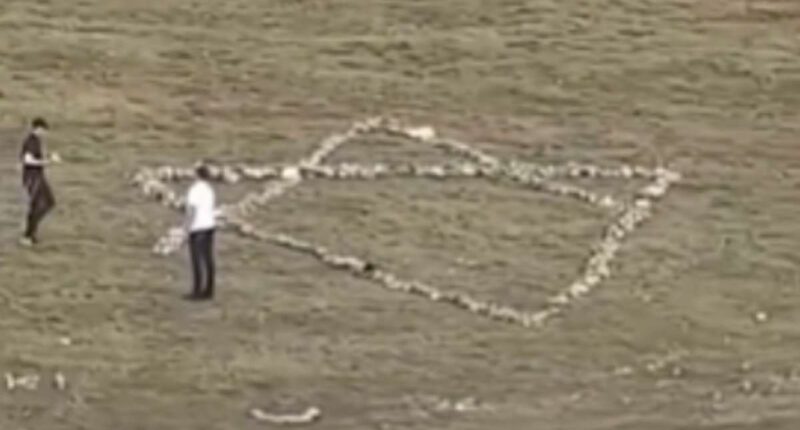Share this @internewscast.com
A group of Jewish tourists were filmed dismantling a landmark cross on a Welsh hillside and using the stones to create a giant Star of David in its place.
The 60ft long cross made from loose stones is believed to have been in place for at least 50 years on the hill below the Great Orme summit in Llandudno, north Wales, a popular tourist spot that is widely known in the local area.
So when footage emerged that appeared to show a group of young people, some apparently wearing traditional kippah headcaps, removing stones from a long-standing Christian symbol, many were furious.
A video posted on a local Facebook group purporting to have been filmed last Friday showed a small group kicking at stones that made up the outline of the cross.
It then shows some of the youngsters using the stones from the cross to make an alternative piece of religious iconography further along the hillside: a Star of David, the symbol of the Jewish faith.
The episode happened near the summit of the 679ft high limestone headland, which has panoramic views of Snowdonia, Anglesey, the Isle of Man, Blackpool and the Lake District.
The clip showed the group working on their version of the six-pointed star, a widely recognised symbol of Jewish identity which appears on Israel’s flag.
It is not known whether they completed it before leaving the hilltop, nor how many stones were removed from the cross or found elsewhere among the many that litter the hillside.

Footage emerged appearing to show a group of young people, some apparently wearing traditional kippah headcaps, removing stones from a long-standing Christian symbol

The footage then shows the youngsters using the stones from the cross to make an alternative piece of religious iconography further along the hillside: a Star of David, the symbol of the Jewish faith

The episode happened near the summit of the 679ft high limestone headland which has panoramic views of Snowdonia, Anglesey, the Isle of Man, Blackpool and the Lake District
Adults who appeared to be with the party that comprised the youths involved are said to have looked on while they moved the stones without interceding.
The incident led to uproar among some locals, with many taking to social media to slam the destruction of the cross on the grass hillside, which is popularly known as ‘The Hill of Names’ because families also often use the rocks to spell out the names of loved ones who have died.
The Facebook user who posted the video stated in his post: ‘Sorry… but this cross has been on the Orme for years… show respect to any religion.’
Locals responded by describing it as ‘disgraceful’ and ‘shocking’, while others accused those responsible of having ‘no respect’ for the Christian landmark.
Another said: ‘If a Christian dismantled a Star of David to build a cross, we would be put in prison and face hate crimes!!…absolutely DISGUSTING!!!’
As news of the damage spread, locals went to the hillside and restored the stones to their original positions and by the end of the weekend, the cross was back in place, and the six-point star had gone.
Scott Puddey, who helped restore the landmark, said: ‘I’ve just been up the Orme and thankfully normal service has been restored. I just finished off the last couple of corners just to make sure, as someone has already cleared most of it.
‘I helped restore the cross not for any religious purpose, just that it’s been a part of Llandudno for more than 50 years and looked after by locals and holidaymakers alike.’

The incident led to uproar among some locals, with many taking to social media to slam the destruction of the cross on the grass hillside, which is popularly known as ‘The Hill of Names’ because families also often use the rocks to spell out the names of loved ones who have died

The Facebook user who posted the video stated in his post: ‘Sorry… but this cross has been on the Orme for years… show respect to any religion’
Another added: ‘Glad the cross has been restored, it’s been there longer than I can remember, well done to whoever restored it.’
North Wales Live reported another local man saying: ‘I am a white British Muslim who lives happily in Llandudno and a large part of my life in Gwynedd.
‘This is not only disrespectful, but as that cross has been there a long time, (it) has become part of the landscape.’
Another added: ‘I’ve got no issue with other people seeing a symbol and being inspired to add their own, but destroying one symbol to add another is such an unbelievably poor choice.’
Some feared the incident would unfairly stir up anger and prejudice against Orthodox Jewish people who had been ‘happily visiting for well over 100 years’.
One person said that Llandudno’s heritage included many ‘lovely Jewish families’ and that they ‘would certainly have something to say about this’.
Another Facebook user commented: ‘These people do not represent Judaism or Israel any more than football hooligans abroad represent Christianity or Britain. Have Jewish friends in Israel that get irritated by people like this.’
Others said it was a shame that the actions of a small minority had caused reputational damage in a town with a long history of Jewish residents and visitors.

Others said it was a shame that the actions of a small minority had caused reputational damage in a town with a long history of Jewish residents and visitors
Professor Nathan Abrams, who has worked to uncover and document stories of Jewish history and heritage in north west Wales, said: ‘These actions, if verified, have been committed by a tiny minority of Jews and should not be allowed to obscure the long history of Jews visiting and living in Llandudno that dates back over a hundred years.
‘Llandudno has and continues to have a fascinating Jewish heritage, which we are continuing to explore.
‘However, these actions in no way justify the outpouring of anti-Semitic prejudice I have read on Facebook, and it didn’t take much to reveal the depth of prejudice bubbling beneath the surface.’
It’s unclear who made up the group involved.
The cross is the biggest and most prominent of a number of designs on the hillside made up of stones from a nearby quarry and is thought to have been first constructed in the 1960s or early 1970s.
Last summer, environmental protest group Just Stop Oil sparked international outrage by attacking the most famous stones in Britain, spraypainting parts of the Stonehenge standing dolmens orange.








